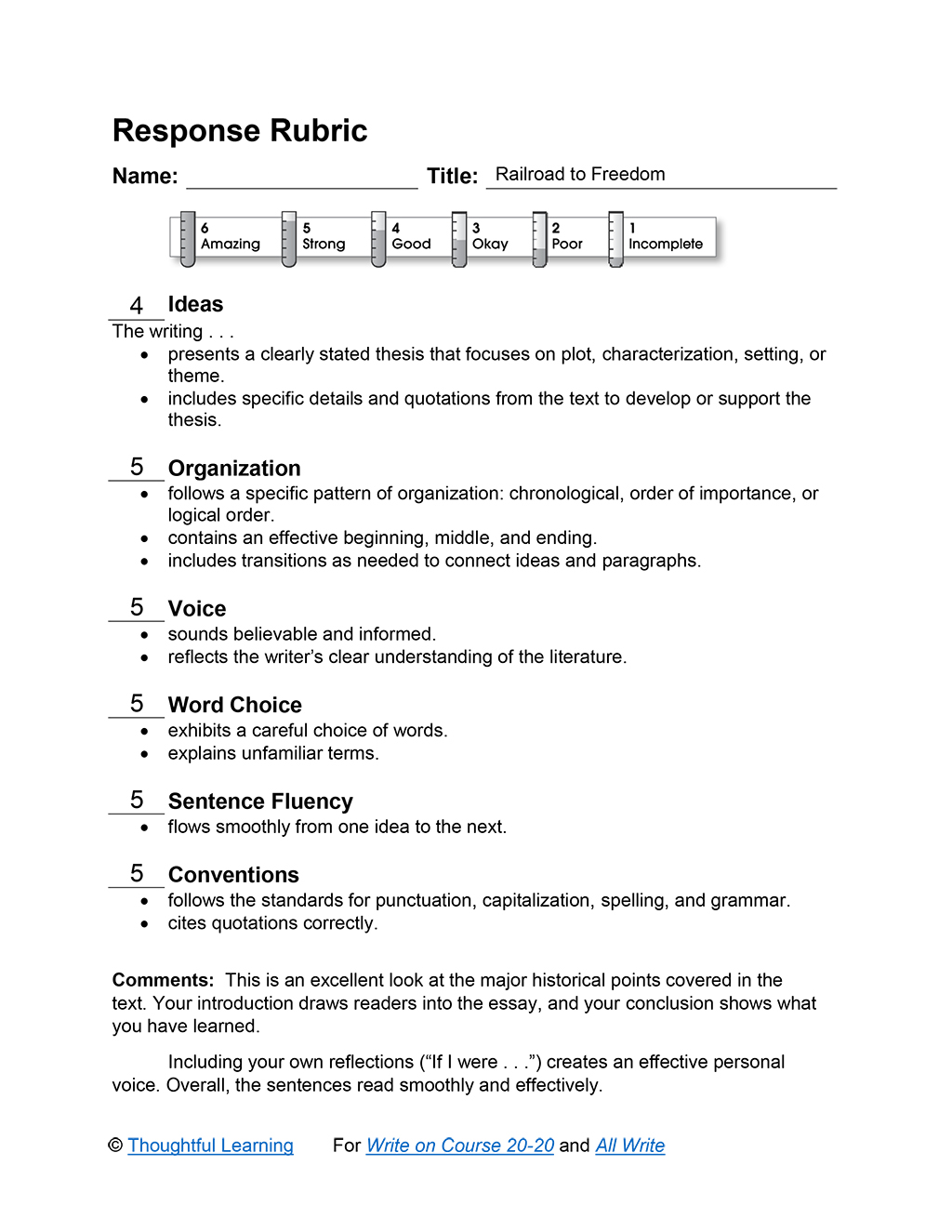Student Model
Railroad to Freedom
“Tonight you will follow the great Mississippi River north. It will guide your feet and the North Star above will guide your eyes,” says Alexander Ross, an abolitionist. If I were a runaway slave, standing in a forest at midnight, I would follow these instructions just like the four slaves did in Runaway to Freedom: A Story of the Underground Railway by Barbara Smucker.
There were several historical facts that interested me in this book. One fact was the Underground Railroad itself. It was exciting the way it worked during the night. The people that helped in the Underground Railroad must have thought this was a very dangerous business. I admire their courage for helping a cause in which they believed (page 109). Another historical fact, actually a person, was Levi Coffin, an abolitionist. He was the “president” of the Railroad. It was interesting to find out why people called him the “president” (page 122). The last historical fact that I found so interesting was that slaves were sold as if they were of no use anymore. It seems like slaves were tools and not really human beings. Even the kindest of masters treated their slaves like tools and this fact really outraged me (page 14).
The first thing I learned from my reading was that the Underground Railroad ran through fourteen states and started four decades before the Civil War. Fugitives, freedmen, Quakers, normal folk, and people who held positions in the government helped out in the Railroad in some way. They did this because of one main reason: they believed slavery was wrong and evil. Slavery had to be stopped and one way to do that was to help slaves escape. Guides or directors usually went with the escaped slaves. These escaped slaves had to go by ship, foot, train, or carriage. If they traveled by day, they would be caught, therefore they traveled by night. Sometimes when they rested during the day they rested at a “station” or a stopping place, which may have been a house. Some escapees were not so successful. If they were caught, they might have been killed or whipped very badly. This was the punishment they were willing to endure for trying to escape.
The second historical fact I found interesting was the work of Levi Coffin. Levi Coffin was an abolitionist who helped out on the Railroad. Despite his Southern upbringing, he hated slavery. Many pictures of the mistreating of slaves stayed in his mind. Confronting slavery firsthand made him despise slavery even more. If I were in his position I would too. Levi Coffin was greatly admired for all of the work he did. He was known as the “president” of the Underground Railroad because he once helped out seventeen slaves at once. Coffin made his house a depot on the route to freedom. At least 3,000 slaves passed through his house. This giant number makes me glad that he acted on his beliefs. He asked neighbors to donate food and supplies for runaways. If Levi needed to, he would go around asking for money or he’d go on speaking tours where he also asked for contributions. In 1877, the great Levi Coffin died, but he will always be known for his notable work in the Underground Railroad.
Two of the four slaves that were running away in this book got caught by bounty hunters. The rescuer of the other two slaves was the Underground Railroad. Others were also helpful, like the Germans in the book. If I were living then I would help too, not just be a bystander.
A question crossed my mind while I was reading Runaway to Freedom. It was this: “Would I have enough courage to run away to free land if I were a slave?” After careful consideration, I think I would be able to, but probably not alone. I would be very afraid of getting caught, but I know that I would have to take action to find freedom.
Despite many obstacles, many runaway slaves made it to freedom. If I were a runaway slave and had reached my destination, I’d feel absolutely exhilarated and happy knowing that I wouldn’t have to worry about being a slave ever again. Many slaves must have felt the same way when they reached Canada or wherever they could be free at last. After reading Runaway to Freedom: The Story of the Underground Railway, I think I have a much better understanding of what being a slave was like.

Rubric


Railroad to Freedom by Thoughtful Learning is licensed under a Creative Commons Attribution-NonCommercial-ShareAlike 4.0 International License.
Based on a work at k12.thoughtfullearning.com/assessmentmodels/railroad-freedom.